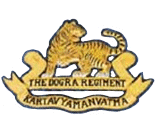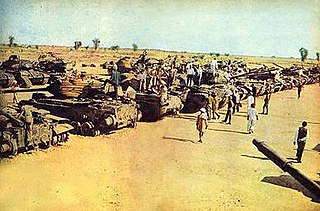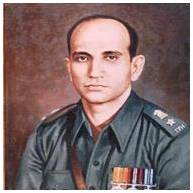
The Indo-Pakistani war of 1965, also known as the second India–Pakistan war, was an armed conflict between Pakistan and India that took place from August 1965 to September 1965. The conflict began following Pakistan's Operation Gibraltar, which was designed to infiltrate forces into Jammu and Kashmir to precipitate an insurgency against Indian rule. The seventeen-week war caused thousands of casualties on both sides and witnessed the largest engagement of armored vehicles and the largest tank battle since World War II. Hostilities between the two countries ended after a ceasefire was declared through UNSC Resolution 211 following a diplomatic intervention by the Soviet Union and the United States, and the subsequent issuance of the Tashkent Declaration. Much of the war was fought by the countries' land forces in Kashmir and along the border between India and Pakistan. This war saw the largest amassing of troops in Kashmir since the Partition of India in 1947, a number that was overshadowed only during the 2001–2002 military standoff between India and Pakistan. Most of the battles were fought by opposing infantry and armored units, with substantial backing from air forces, and naval operations.
The 1st Armoured Division is an armoured division of the Indian Army, headquartered at Patiala, Punjab. It is part of II Corps of the Indian Army's Western Command.

The Dogra Regiment is an infantry regiment of the Indian Army. The regiment traces its roots directly from the 17th Dogra Regiment of the British Indian Army. When transferred to the Indian Army like its sister regiments, the numeral prefix was removed. Units of the Dogra Regiment have fought in all conflicts that independent India has been engaged in, making it one of the most prestigious and most decorated regiments of the Indian Army.

The Battle of Asal Uttar was one of the largest tank battles fought during the Indo-Pakistani War of 1965. It was fought from 8 to 10 September 1965, when the Pakistan Army thrust its tanks and infantry into Indian territory, capturing the Indian town of Khemkaran 5 km from the International Border. The Indian troops retaliated, and after three days of bitter fighting, the battle ended with the Pakistani forces being repulsed near Asal Uttar. Factors that contributed to this were the fierce fight put up by the Indian Army, conditions of the plains, better Indian tactics, and a successful Indian strategy.

Operation Gibraltar was the codename of a military operation planned and executed by the Pakistan Army in the territory of Jammu and Kashmir, India in August 1965. The operation's strategy was to covertly cross the Line of Control (LoC) and incite the Muslim-majority Kashmiri population's uprising against the Indian Government. The military leadership believed that a rebellion by the local Kashmiri population against Indian authorities would serve as Pakistan's casus belli against India on the international stage.

The Battle of Chawinda was a major engagement between Pakistan and India in the Second Kashmir War as part of the Sialkot campaign. It is well known as being one of the largest tank battles in history since the Battle of Kursk, which was fought between the Soviet Union and Nazi Germany in World War II.

Lieutenant Colonel Ardeshir Burzorji Tarapore, PVC, was an Indian military officer and posthumous recipient of India's highest military award, the Param Vir Chakra. After completing his schooling in Pune, Tarapore joined the Hyderabad Army, and was commissioned in January 1942. Initially he joined the infantry, but was later transferred to an armoured regiment, the 1st Hyderabad Imperial Service Lancers. During World War II, Tarapore saw action in the Middle Eastern theatre of the war.

Company Quartermaster Havildar Abdul Hamid Idrishi, was an Indian soldier. He was posthumously given India's highest military decoration, the Param Vir Chakra, for his actions during the Indo-Pakistani War of 1965.

The Battle of Ichogil Bund also known as the Battle of BRB Canal was a skirmish fought from 22 September to 23 September 1965 as part of the Indo-Pakistani War of 1965 by the 9th Battalion Madras Regiment, under the command of Lieutenant Colonel B.K. Satyan.

The 10th Indian Infantry Division was a war formed infantry division of the Indian Army during World War II. In four years, the division travelled over 4,000 miles (6,400 km) from Tehran to Trieste, fought three small wars, and fought two great campaigns: the Anglo-Iraqi War, the Invasion of Syria–Lebanon, the Anglo-Soviet invasion of Iran, the North African Campaign, and the Italian Campaign.

Defence Day is celebrated in Pakistan as a national day to commemorate the sacrifices made by Pakistani soldiers in defending its borders. The date of 6 September marks the day in 1965 when Indian troops crossed the international border to launch an attack on Pakistani Punjab, in a riposte to Pakistan's Operation Grand Slam targeting Jammu. While it is officially commemorated as an unprovoked surprise attack by India, repulsed by the Pakistan Army despite its smaller size and fewer armaments, the narrative has been criticised by Indian commentators as representing false history.
The 11th Infantry Division is an active formation of the Pakistan Army. It is currently deployed in Lahore as part of IV Corps, and is responsible for the defence of that city and the surrounding areas.

The 6th Armoured Division is a Pakistan Army armoured division currently based in Gujranwala, in Punjab Province.

The Battle of Phillora was a large tank battle fought during the Indo-Pakistani War of 1965. It commenced on 10 September when the Indian 1st Armoured Division, with four armoured regiments and supporting forces under command, attacked positions in the Sialkot sector held by Pakistani 6th Armoured Division. After three days the Pakistanis withdrew with the loss of 66 tanks. The Indians admitted to the loss of 6 Centurions.

The Indian Army has a distinguished history in which they won many battle and theatre honours. The practice of giving battle honours began with the East India Company who awarded these to the units of the native Indian corps in their presidency armies. The practice continued after the advent of the British Crown post-1857 when the armies of the East India Company became part of the British Indian Army and even after India's independence in 1947. The earliest conflict for which a battle honour was awarded was "Plassey" which was awarded in 1829 to the 1st Regiment, Bengal Native Infantry which served the East India Company in Bengal while the latest is "Kargil" in 1999 awarded to units of independent India's army for feats during the Kargil War.

The Battle of Burki was fought by Indian infantry and Pakistani armour in the Indo-Pakistani War of 1965. Burki is a village, that lies south-east of Lahore near the border with Punjab. For reference, that is just 11 km from the Allama Iqbal International Airport in Lahore, and is connected to Lahore by the a bridge over the Bambawali-Ravi-Bedian (BRB) Canal. During the battle, the strength of the two sides were relatively even. Indian infantry clashed with Pakistani forces that were entrenched in pillboxes, dug-outs and slit trenches that had been carved into the canal banks. The Pakistanis were supported by a large number of tanks, as well as fighter jets. The battle resulted in an Indian victory.

Air Force Day is celebrated in Pakistan as a national day on 7 September, after the annual celebration of the Defence Day. Airshows and other programs mark the Pakistan Air Force's (PAF) role in defending the nation in the Indo-Pakistani War of 1965.
The Battle of Dograi was a military engagement from 20 to 22 September 1965, during the Indo-Pakistani War of 1965. It took place in the area of Dograi village on the outskirts of Lahore in Pakistani Punjab.
The Battle of Haji Pir pass was a military engagement from 26 to 28 August 1965, during the Indo-Pakistani War of 1965 and resulted in India capturing the entire Haji Pir bulge including the 8,652 feet high Haji Pir pass in Pakistan-administered Kashmir.
Brigadier Thomas Krishnan Theogaraj (1919-2001) was a senior officer in the Indian Army. Brigadier Theogaraj commanded the 2nd Independent Armored Brigade and played a key role during the Indo-Pakistan War of 1965. For his role in the war he was awarded the Maha Vir Chakra.















